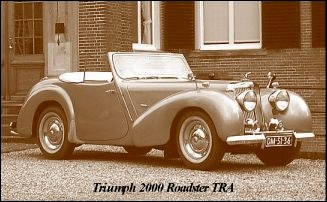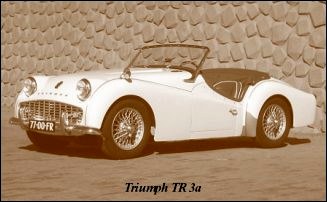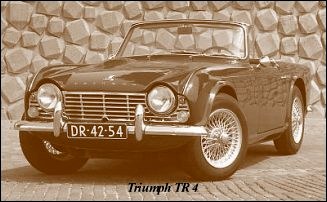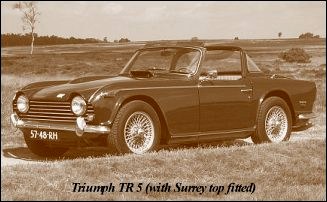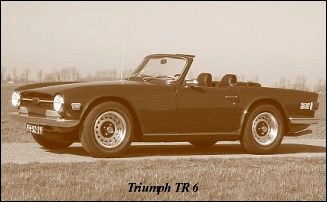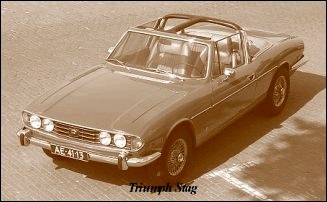|
Triumph built
and marketed their first car in the year 1923; the Triumph 10/20. In the
two decades before Triumph had built up an excellent name in the
manufacture of bicycles and motorcycles. After the
second world war Mr. John Black, owner of Standard Motor Company, was
thinking about how to improve his product-line of cars. Standard
delivered engines to Swallow Sidecar Company (soon thereafter to be
known as Jaguar Cars) who build nice sports cars fitted with the Standard
engines. John Black and his people started right away to bring Triumph back on wheels again. They build the Triumph 1800 based on a Standard chassis and equipped with the 1800 engine they delivered to S.S. Cars. The 1800 came onto the market in 1946. There where two models, the 18T Saloon and the 18 TR Roadster. The Triumph 1800 TR roadster was not quite the sports car John Black expected it to be. The cylinder capacity was enlarged up to 2000 cc. which resulted in the introduction of the Triumph Roadster 2000TR(A).
In the year 1948 Jaguar Cars (just like Standard-Triumph located in
Coventry) astonished the entire automobile industry with the Jaguar XK
120. This very slick sports car with it's all enveloping body must have
been inspired by the prewar BMW racing cars... but the XK 120 was for
road use, it topped 120 miles per hour and it was far more affordable
than other exotic cars like the Ferrari and Aston Martin.
The year 1955 saw the introduction of the Triumph TR 3 ,
the first production car with factory fitted disc brakes at front. The TR
2 design was slightly changed, Triumph introduced a new radiator grille. Triumph hired the successful Italian designer Michelotti in the fifties of the nineteenth century to design a compact family car, the Triumph Herald. In this period the board of directors were fed up with the stubborn and unpredictable behavior of Sir John Black; they sacked him. John Black's assistant Allick Dick took his place. Allick Dick was convinced that Triumph-Standard needed a strong partner to stay in business during the years to come. They started successful negotiations with Leyland Truck & Bus company which resulted in the founding of Leyland Motor Corporation in 1961.
Triumphs new
technical director Harry Webster was very impressed by Michelotti's
designs so he asked him to design a successor for the Triumph TR 3.
Additionally he asked Michelotti to design a completely new sports car,
smaller and cheaper, to compete with MG. The MG competitor was born in
1962; the Triumph Spitfire.
The Triumph
TR 4 was in large based on TR 3b mechanics but it was a
completely different car by design. Clear flowing lines and a compact purposeful
look made the TR 4 a very handsome sports car. Functionally a lot
changed; the interior offered more space as did the booth, the engine room
was larger and easier to reach and the car was fitted with
roll up windows.
In the year 1967
the six cylinder Triumph TR 5 was presented, the TR 5 was
the first car factory fitted with a petrol injection system. This
mechanical injection system was manufactured by Lucas. The TR 5 was in
fact a Triumph TR 4a fitted with a six cylinder engine. In the late sixties Triumph was working on a prestigious project, developing an entirely new car and engine which would later result in the Triumph Stag. The project consumed an awesome amount of money and Triumph had to come with a Triumph TR 5 successor soon because the TR 4 looks of the TR 5/250 ran out of date.
All Triumph Engineering capacity was dedicated to the new project
and Triumph had not much money to spend on the TR 5 successor. Triumph
got in touch with Karmann company located in Osnabruck, Germany.
Karmann had the possibilities and means to design and develop the new
car and was also able to manufacture all the tooling. Karmann decided to
redesign the front and rear of Michelotti's original TR 4 design and not
to touch the structure underneath and the cockpit-area.
The prestigious project, mentioned above, gave birth to the Triumph Stag in 1970. The Stag was a real safety-car, it featured a roll-over bar and a safety interior with all padded surfaces. The engine was a newly developed 2997 cc. V8 engine. The Stag was not a real sports car but more like an open GT, comfortable and fast. The greater part of Stag production was shipped to the USA fitted with an automatic gearbox. In the early seventies competition got tougher on the important US market and a safety hype against open cars was not helping either. This was all in advantage of the most important TR competitor, the newly introduced Datsun 240 Z a 6 cylinder, 150 bhp. GT coupe sports car. Triumph tried to compete by introducing the wedge shaped Triumph TR 7 in 1975 but regretfully fitted the car with a 105 bhp. four cylinder engine instead of a "hairy" and powerful six... 1980 saw the
introduction of the Triumph TR 8, a TR 7 convertible with
the powerful Rover V8 under the bonnet. At present
day the make Triumph is a "sleeper". According to our
sources the make is owned by the Rover-Group. Click here to view a large and detailed selection of Triumph models in the ClassicarImages archives. * |
